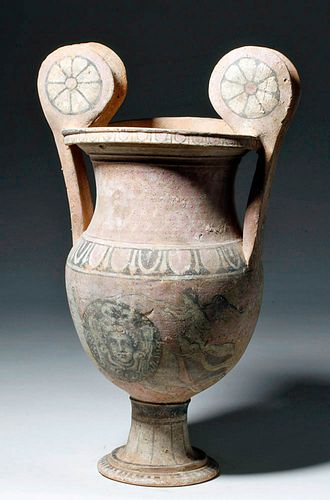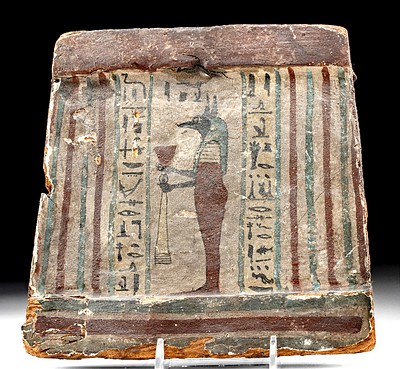Stunning Canosan Polychrome Krater w/ Medusa
Lot 25c
About Seller
Artemis Fine Arts
686 S Taylor Ave, Ste 106
Louisville, CO 80027
United States
Selling antiquities, ancient and ethnographic art online since 1993, Artemis Gallery specializes in Classical Antiquities (Egyptian, Greek, Roman, Near Eastern), Asian, Pre-Columbian, African / Tribal / Oceanographic art. Our extensive inventory includes pottery, stone, metal, wood, glass and textil...Read more
Categories
Estimate:
$9,000 - $13,500
Absentee vs Live bid
Two ways to bid:
- Leave a max absentee bid and the platform will bid on your behalf up to your maximum bid during the live auction.
- Bid live during the auction and your bids will be submitted real-time to the auctioneer.
Bid Increments
| Price | Bid Increment |
|---|---|
| $0 | $25 |
| $300 | $50 |
| $1,000 | $100 |
| $2,000 | $250 |
| $5,000 | $500 |
| $10,000 | $1,000 |
| $20,000 | $2,500 |
| $50,000 | $5,000 |
| $100,000 | $10,000 |
| $200,000 | $20,000 |
About Auction
By Artemis Fine Arts
Aug 26, 2021
Set Reminder
2021-08-26 10:00:00
2021-08-26 10:00:00
America/New_York
Bidsquare
Bidsquare : Fine Antiquities | Asian | Ethnographic Art
https://www.bidsquare.com/auctions/artemis-gallery/fine-antiquities-asian-ethnographic-art-7366
Features classical antiquities, ancient and ethnographic art from cultures encompassing the globe. Egyptian, Greek, Roman, Etruscan, Near Eastern, Asian, Pre-Columbian, Native American, African / Tribal, Oceanic, Spanish Colonial, Russian, Fine / Visual Arts, so much more! Artemis Fine Arts info@artemisgallery.com
Features classical antiquities, ancient and ethnographic art from cultures encompassing the globe. Egyptian, Greek, Roman, Etruscan, Near Eastern, Asian, Pre-Columbian, Native American, African / Tribal, Oceanic, Spanish Colonial, Russian, Fine / Visual Arts, so much more! Artemis Fine Arts info@artemisgallery.com
- Lot Description
Magna Graecia, Apulia, Canosan Hellenistic Period, ca. 3rd century BCE. A well-proportioned funerary volute krater with twin large curled volutes perched on the rim. It stands on a pronounced, flared foot, and has a nicely delineated neck and apple-shaped body. This is painted all over with designs that are white, black, and a pale pink. Looping abstract designs define the shoulder, rim, and foot; wheel-like designs are painted onto the volutes. Many such vessels were painted with an image of the god Hermes standing in his chariot drawn by four horses; the messenger god also served as the guide for souls journeying to the underworld. Here, however, we have a woman, probably Eos (Aurora), sister of Helios, the sun. Italo-Greek vase painters liked to portray her as a winged woman on a chariot, as she appears here, with her long white chiton flowing out behind her as her single white horse heralds the dawn. She functions as a beautiful visual shorthand for the arrival of Hermes (often shown in other contemporary artwork being led behind her). Transposed over the body of the horse is a face, painted to look like a stone carving, is a face with a serious expression and what appear to be wings behind the head. The stylistic difference between the painting of Eos and that of the head suggests that the vase may have been pre-painted with the image of Eos and the head added later; the face may be modeled on the death mask of the real person whose tomb this vessel once graced. Size: 8" W x 13.25" H (20.3 cm x 33.7 cm)
Canosa - Canusion, in antiquity - was a major center of the ceramics and pottery trade when it was a Greek polis. It produced truly unique pottery, completely different in decoration style (although not in shape) from earlier and neighboring traditions. The clay is buff, with the decoration applied directly to it without the use of slip; the pink here is one of the unique colors found on these vessels. The hole in the bottom of the vase signifies that this was made solely for funerary purposes (and it's quite cool to look inside and see the clay that was pushed up through the bottom to form a hole). In ancient Greek practice, a bottomless vase like this was placed over a grave and offerings like wine were poured straight through it. Others, like this one, were never used but were buried in the tomb beside the deceased to evoke this custom. The funerary theme of the piece also indicates that it was made solely for burial purposes.
This piece has been tested using thermoluminescence (TL) and has been found to be ancient and of the period stated. A full report will accompany purchase.
Provenance: ex-private Florida, USA collection; ex-private United Kingdom collection, acquired 1970s to 2000
All items legal to buy/sell under U.S. Statute covering cultural patrimony Code 2600, CHAPTER 14, and are guaranteed to be as described or your money back.
A Certificate of Authenticity will accompany all winning bids.
PLEASE NOTE: Due to recent increases of shipments being seized by Australian & German customs (even for items with pre-UNESCO provenance), we will no longer ship most antiquities and ancient Chinese art to Australia & Germany. For categories of items that are acceptable to ship to Australia or Germany, please contact us directly or work with your local customs brokerage firm.
Display stands not described as included/custom in the item description are for photography purposes only and will not be included with the item upon shipping.
#117045Areas of repainting; base and rim have been repaired, with repairs well done and difficult to see.Condition
- Shipping Info
-
All shipping is handled in-house for your convenience. Your invoice from Artemis Gallery will include shipping calculation instructions. If in doubt, please inquire BEFORE bidding for estimated shipping costs for individual items.
-
- Buyer's Premium



 EUR
EUR CAD
CAD AUD
AUD GBP
GBP MXN
MXN HKD
HKD CNY
CNY MYR
MYR SEK
SEK SGD
SGD CHF
CHF THB
THB



















